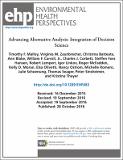| dc.contributor.author | Malloy, Timothy F. | |
| dc.contributor.author | Zaunbrecher, Virginia M. | |
| dc.contributor.author | Batteate, Christina | |
| dc.contributor.author | Blake, Ann | |
| dc.contributor.author | Carroll, William F. | |
| dc.contributor.author | Corbett, Charles J. | |
| dc.contributor.author | Hansen, Steffen Foss | |
| dc.contributor.author | Lempert, Robert | |
| dc.contributor.author | Linkov, Igor | |
| dc.contributor.author | McFadden, Roger | |
| dc.contributor.author | Ostrom, Nancy | |
| dc.contributor.author | Romero, Michelle | |
| dc.contributor.author | Schoenung, Julie | |
| dc.contributor.author | Seager, Thomas | |
| dc.contributor.author | Sinsheimer, Peter | |
| dc.contributor.author | Thayer, Kristina | |
| dc.contributor.author | Moran, Kelly H. | |
| dc.contributor.author | Olivetti, Elsa A. | |
| dc.date.accessioned | 2017-04-04T16:44:30Z | |
| dc.date.available | 2017-04-04T16:44:30Z | |
| dc.date.issued | 2016-10 | |
| dc.date.submitted | 2016-09 | |
| dc.identifier.issn | 0091-6765 | |
| dc.identifier.uri | http://hdl.handle.net/1721.1/107840 | |
| dc.description.abstract | Background: Decision analysis—a systematic approach to solving complex problems
—offers tools and frameworks to support decision making that are increasingly being applied to environmental challenges. Alternatives analysis is a method used in regulation and product design to identify, compare, and evaluate the safety and viability of potential substitutes for hazardous chemicals. Objectives: Assess whether decision science may assist the alternatives analysis decision maker in comparing alternatives across a range of metrics. Methods: A workshop was convened that included representatives from government, academia, business, and civil society and included experts in toxicology, decision science, alternatives assessment, engineering, and law and policy. Participants were divided into two groups and prompted with targeted questions. Throughout the workshop, the groups periodically came together in plenary sessions to reflect on other groups’ findings. Discussion: We conclude the further incorporation of decision science into alternatives analysis would advance the ability of companies and regulators to select alternatives to harmful ingredients, and would also advance the science of decision analysis. Conclusions: We advance four recommendations: (1) engaging the systematic development and evaluation of decision approaches and tools; (2) using case studies to advance the integration of decision analysis into alternatives analysis; (3) supporting transdisciplinary research; and (4) supporting education and outreach efforts.
. | en_US |
| dc.description.sponsorship | National Science Foundation (U.S.) ((NSF DBI-0830117) | en_US |
| dc.description.sponsorship | National Science Foundation (U.S.) (NSF DBI-1266377) | en_US |
| dc.description.sponsorship | United States. Environmental Protection Agency | en_US |
| dc.language.iso | en_US | |
| dc.publisher | Environmental Health Perspectives | en_US |
| dc.relation.isversionof | http://dx.doi.org/10.1289/ehp483 | en_US |
| dc.rights | Article is made available in accordance with the publisher's policy and may be subject to US copyright law. Please refer to the publisher's site for terms of use. | en_US |
| dc.source | National Institute of Environmental Health Sciences | en_US |
| dc.title | Advancing Alternative Analysis: Integration of Decision Science | en_US |
| dc.type | Article | en_US |
| dc.identifier.citation | Malloy, Timothy F., Virginia M. Zaunbrecher, Christina Batteate, Ann Blake, William F. Carroll, Charles J. Corbett, Steffen Foss Hansen, et al. “Advancing Alternative Analysis: Integration of Decision Science.” Environmental Health Perspectives (October 28, 2016). | en_US |
| dc.contributor.department | MIT Institute for Data, Systems, and Society | en_US |
| dc.contributor.department | Massachusetts Institute of Technology. Materials Processing Center | en_US |
| dc.contributor.department | Lincoln Laboratory | en_US |
| dc.contributor.department | Massachusetts Institute of Technology. Department of Materials Science and Engineering | en_US |
| dc.contributor.department | MIT Energy Initiative | en_US |
| dc.contributor.mitauthor | Moran, Kelly H. | |
| dc.contributor.mitauthor | Olivetti, Elsa A. | |
| dc.relation.journal | Environmental Health Perspectives | en_US |
| dc.eprint.version | Final published version | en_US |
| dc.type.uri | http://purl.org/eprint/type/JournalArticle | en_US |
| eprint.status | http://purl.org/eprint/status/PeerReviewed | en_US |
| dspace.orderedauthors | Malloy, Timothy F.; Zaunbrecher, Virginia M.; Batteate, Christina; Blake, Ann; Carroll, William F.; Corbett, Charles J.; Hansen, Steffen Foss; Lempert, Robert; Linkov, Igor; McFadden, Roger; Moran, Kelly D.; Olivetti, Elsa; Ostrom, Nancy; Romero, Michelle; Schoenung, Julie; Seager, Thomas; Sinsheimer, Peter; Thayer, Kristina | en_US |
| dspace.embargo.terms | N | en_US |
| dc.identifier.orcid | https://orcid.org/0000-0002-8043-2385 | |
| mit.license | PUBLISHER_POLICY | en_US |
